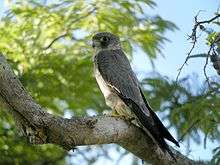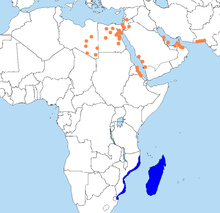Sooty falcon
The sooty falcon (Falco concolor) is a medium-sized falcon breeding from northeastern Africa to the southern Persian Gulf region.
| Sooty falcon | |
|---|---|
 | |
| Allée Des Baobabs near Morondava, Madagascar | |
| Scientific classification | |
| Kingdom: | Animalia |
| Phylum: | Chordata |
| Class: | Aves |
| Order: | Falconiformes |
| Family: | Falconidae |
| Genus: | Falco |
| Species: | F. concolor |
| Binomial name | |
| Falco concolor Temminck, 1825 | |
 | |
| Global range. Orange dots: Breeding colonies Blue: Wintering range | |
Taxonomy
The sooty falcon belongs to the hobby group, a rather close-knit number of similar falcons often considered a subgenus Hypotriorchis. Eleonora's falcon is sometimes considered its closest relative, but while they certainly belong to the same lineage, they do not seem to be close sister species.[2][3]
Description
This is an elegant bird of prey, 32–37 cm long with a 78–90 cm wingspan. It is shaped like a large hobby or a small Eleonora's falcon, with its long pointed wings, long tail and slim body. The adults are blue-grey, and lack the black underwing coverts of the Eleonora's falcon. The young bird is like a large juvenile hobby, or small juvenile Eleanora's falcon. Its dark trailing edge to the wings and tail distinguish it from the former species, and it lacks the underwing contrast caused by the dark coverts of the larger falcon.[4]
Distribution and habitat
This species breeds on islands and coastal or desert cliffs from Libya to Pakistan). It is a long-distance migrant, wintering in east Africa and south to Madagascar and north-eastern South Africa. Increasingly regular sightings and a lack of historical records suggests that the wintering range has expanded south in recent decades.[4] It is a rare vagrant north of its breeding range.
Ecology
The sooty falcon eats mainly birds, but it will take large insects, such as dragonflies, which are transferred from talons to beak and eaten in flight. It nests on a ledge or on rocks, laying up to four eggs.[4]
Sooty Falcons lay eggs during mid-summer, and unlike most other falcons, occasionally nest in colonies. Birds nesting on islands in the Sea of Oman have a mean clutch size of 2.83 and brood size of 2.11, with 12% of nests failing at the egg or nesting stage.[5]
Conservation
It was formerly classified as Least Concern by the IUCN, but has recently been shown to be rarer than formerly believed. Consequently, it was uplisted to Vulnerable status in 2017.[1] The breeding population of Sooty falcons on the islands of northern Oman is in decline, with human disturbance on accessible islands a likely cause, as falcons breeding close to beaches have lower nesting success than those breeding further away.[6]
References
- BirdLife International. 2017. Falco concolor. The IUCN Red List of Threatened Species 2017: e.T22696446A119400295. https://dx.doi.org/10.2305/IUCN.UK.2017-3.RLTS.T22696446A119400295.en. Downloaded on 01 January 2019.
- Helbig, A.J.; Seibold, I.; Bednarek, W.; Brüning, H.; Gaucher, P.; Ristow, D.; Scharlau, W.; Schmidl, D.; Wink, Michael (1994). "Phylogenetic relationships among falcon species (genus Falco) according to DNA sequence variation of the cytochrome b gene" (PDF). In Meyburg, B.-U.; Chancellor, R.D. (eds.). Raptor conservation today. pp. 593–599.
- Wink, Michael; Seibold, I.; Lotfikhah, F.; Bednarek, W. (1998). "Molecular systematics of holarctic raptors (Order Falconiformes)" (PDF). In Chancellor, R.D.; Meyburg, B.-U.; Ferrero, J.J. (eds.). Holarctic Birds of Prey. Adenex & WWGBP. pp. 29–48.
- Gibbon, G. (2012). Roberts VII Multimedia Birds of Southern Africa (iPhone version 2 ed.).
- McGrady, M. J.; Fazari, W. A.; Jahdhami, M. H.; Nicoll, M. A. C.; Oli, M. K. (2017). "Sooty Falcon Falco concolor reproduction and population dynamics on the islands in the Sea of Oman". Ibis. 159 (4): 828–840. doi:10.1111/ibi.12502.
- Mcrady, M.J.; Fazari, W.A.; Jahdhami, M.A.; Fisher, M..; Kwarteng, A.Y.; Walter, H.; Oli, M.K. (2019). "Island accessibility and distance from beach influence nesting success of Sooty Falcons Falco concolor in Oman". Ibis. 161 (2): 162–171. doi:10.1111/ibi.12601.
External links
- Sooty falcon - Species text in The Atlas of Southern African Birds.
